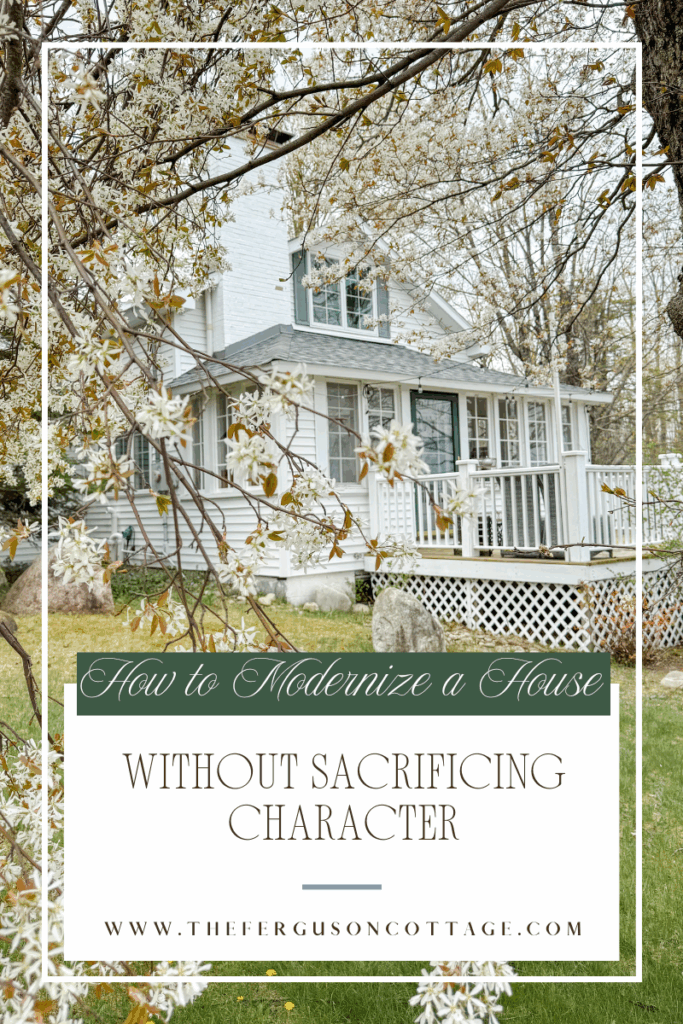Jul 22, 2025
You Don’t Have to Gut it to Update It: How to Modernize an Old House Without Losing the Character
If you’re living in an older or historic home — especially in places like Northern Michigan, where cottages and lake houses have evolved over generations — you might be wondering how to modernize your house without a complete renovation. The good news? You don’t have to gut it to update it.
Not every outdated room, kitchen, or bathroom needs to be a full demolition project. In fact, many older homes — particularly those with history and craftsmanship — offer so much to work with. There’s a big difference between addressing foundational or structural issues and removing every bit of original charm just to start from scratch.
Yes, we want to make sure that everything behind the walls is sound. Electrical, plumbing, insulation — those are non-negotiables when it comes to safety. But the finishes? The details? The personality of the home? That’s where you have options. This is where preserving character in home renovations becomes key.

Honor the Home’s Story While You Update
Your home tells a story. And just like in good design, the goal is to let that story unfold cohesively — not to interrupt it with trendy finishes or disconnected styles.
One of the biggest mistakes I see in renovations is when updates feel disjointed. You walk into a 1950s bathroom, then suddenly land in a brand-new kitchen that feels like a showroom from 2025, followed by a bedroom clearly last updated in 1986. It’s jarring. It lacks flow. And most of all, it loses the narrative that makes a home feel truly whole.
But it doesn’t have to be that way. There are ways to blend old and new in home design so that updates feel intentional — not like a renovation shouting for attention.
Simple Ways to Update an Old Home Without Losing Its Charm
- Salvage original materials wherever possible — tile, wood floors, trim, or hardware.
- Repeat flooring across rooms to create consistency (or match new to original when salvaging isn’t possible).
- Stick to a whole-house color scheme to unify even different architectural eras.
- Use period-appropriate details like light fixtures or cabinet hardware to maintain a classic look.
- Match door hardware, hinges, and finishes to create subtle continuity throughout the home.
The result is a space that flows beautifully — even if parts were built decades apart.
What if you leaned into your 1950s roots and added vintage tile in your new kitchen? Or kept those brass doorknobs that still work perfectly fine? These kinds of thoughtful decisions create a space that feels authentic — not like a house that was flipped overnight.
What If My House Has No Original Charm?
If your house was stripped by a flipper or is a basic builder-grade home from the 1990s or early 2000s, you might feel like there’s nothing to preserve. But this is your opportunity to add charm and character — to give your home a story.
Just be careful not to fall into the trap of trends. Updating your home without gutting it also means being intentional. If everything in the renovation is sourced from the same big-box retailer, the result can feel more like a catalog than a home.
Take inspiration from timeless design movements: traditional, coastal, cottage, or mid-century modern. Mix styles if they speak to you — just be sure they also speak to the architecture of your house. And always focus on function first — aesthetics mean little if the home doesn’t work well for your family.
Common Renovation Mistakes to Avoid (No Matter the Home’s Age)
- Laying LVP or faux wood tile right next to real hardwood — especially in homes with original stained trim
- Using trendy hardware finishes (brushed gold and matte black may not suit every home style)
- Labeling your home as one specific style — “modern farmhouse,” “Nancy Meyers,” “shabby chic,” etc.
- Ignoring function and focusing solely on aesthetics
- Mixing design decades in a way that disrupts flow rather than enhancing it
Especially in Northern Michigan…
Here in Northern Michigan, it’s common to find homes that have been added onto over time. Many lake cottages and family cabins started small and expanded through the decades. While these homes often feel disjointed at first, they also hold incredible potential.
I’ve worked with homeowners who think the only solution is to gut the entire house and start over. But complete demolition isn’t always the answer.
Instead, try working with the existing architecture. Keep the original floors. Save the trimwork. Let the home’s unique layers show through — while enhancing function and making it work for modern life.
Even homes from the 1980s or 90s (which aren’t always considered “charming”) can benefit from this approach. You’re never going to erase the fact that your home was built in a certain era — but you can embrace it, elevate it, and help it grow into something more cohesive, beautiful, and uniquely yours.
The Bottom Line: Renovate Thoughtfully
Whether you’re preserving a 1920s cottage or trying to make a 2001 build feel special, the goal is the same: make updates that respect your home’s story while making it work better for your life.
Avoid the full-gut default. Choose timeless over trendy. And always, always let your design reflect your home’s personality — and yours.
Need Help With Your Own Renovation?
If you’re thinking about renovating a historic home in Northern Michigan, or you just want to make your current space feel more cohesive, I’d love to help. Together, we can create a design that brings function, flow, and story back to your home — without losing the character that makes it special.

LEAVE A COMMENT
View Comments